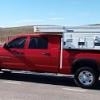I recently noticed the following. Ram Truck and 2018 Grandby camper sits in fog, gray skies and rain for a number of days. The solar panels (2 x 100 watt) don't quite keep the two AGM batteries floated in this weather.
I take the truck out for a long drive, expecting the FWC installed wiring to my truck battery/alternator and separator to bring up the batteries but when I return home they are lower then when I left.
Once the engine of the truck is shut off, I observe my Overland Solar MPPT display unit. I see they are in BULK and as I watch the voltage display, I see the display then slowly climb from say 13.2 volts to the normal 13.8 float.
I noticed this has happened on 4 hour drives also. When we arrive at the campground, the AGM batteries have gone from 13.8 volts in float when we left to 12.9 volts and BULK when we arrive. Once the camper sits for a while in partial sun, the batteries start coming back up. All this info occurs when the battery disconnect is active meaning nothing should be drawing power from the AGM batteries.
My question is whether or not something is drawing power away from the AGM batteries when my truck is running instead of the opposite, actually charging the batteries. Not sure yet how to diagnosis but will start looking into. The first 6 months of ownership this did not happen but the last 4 months it has.
Thank you,

















